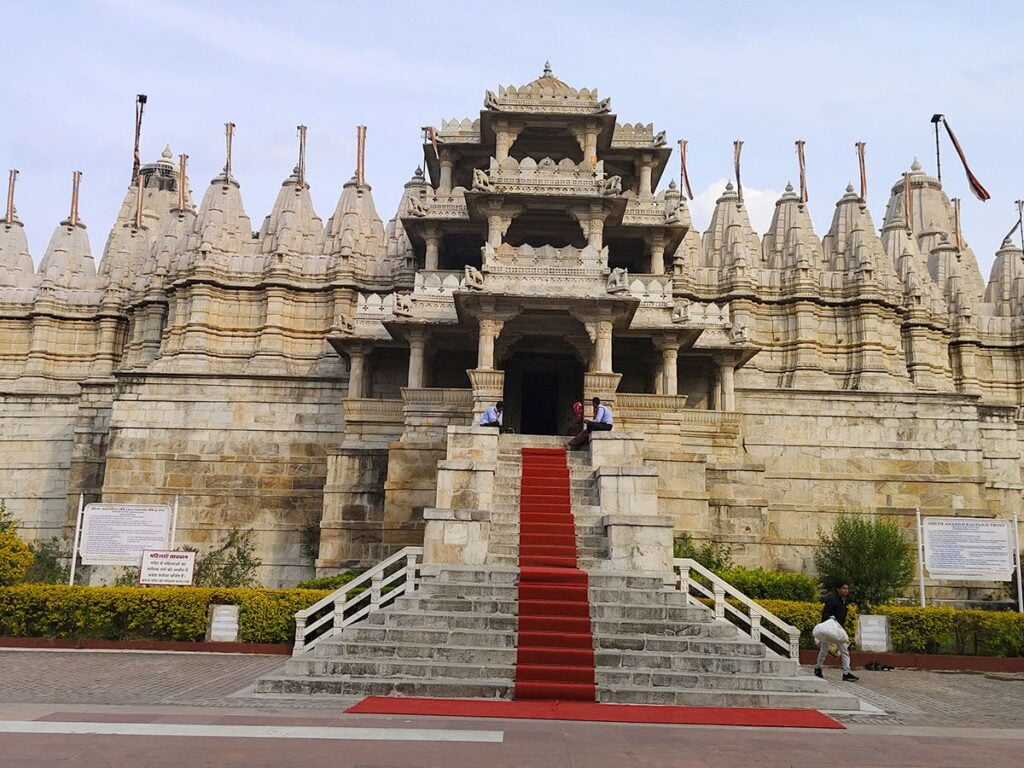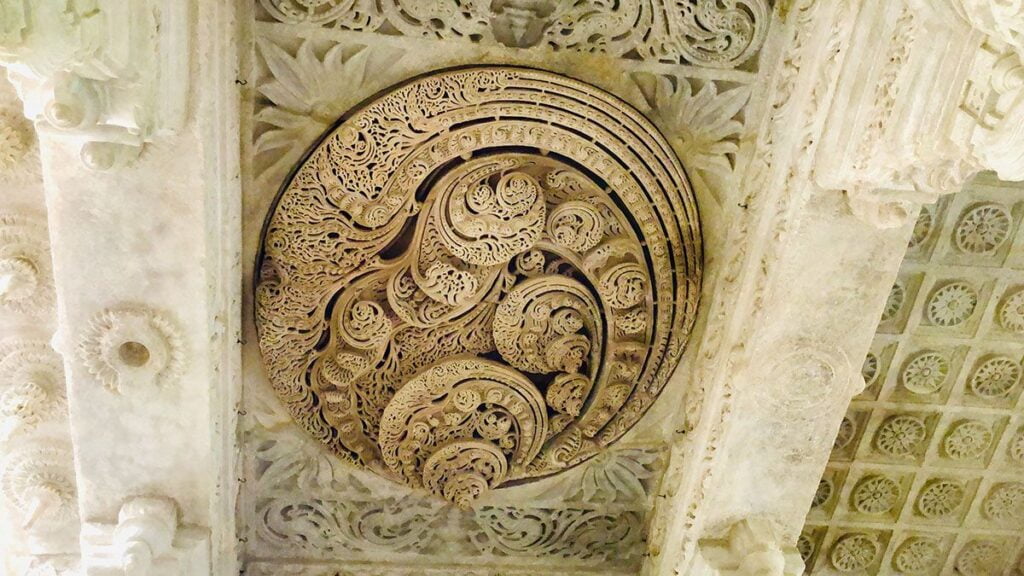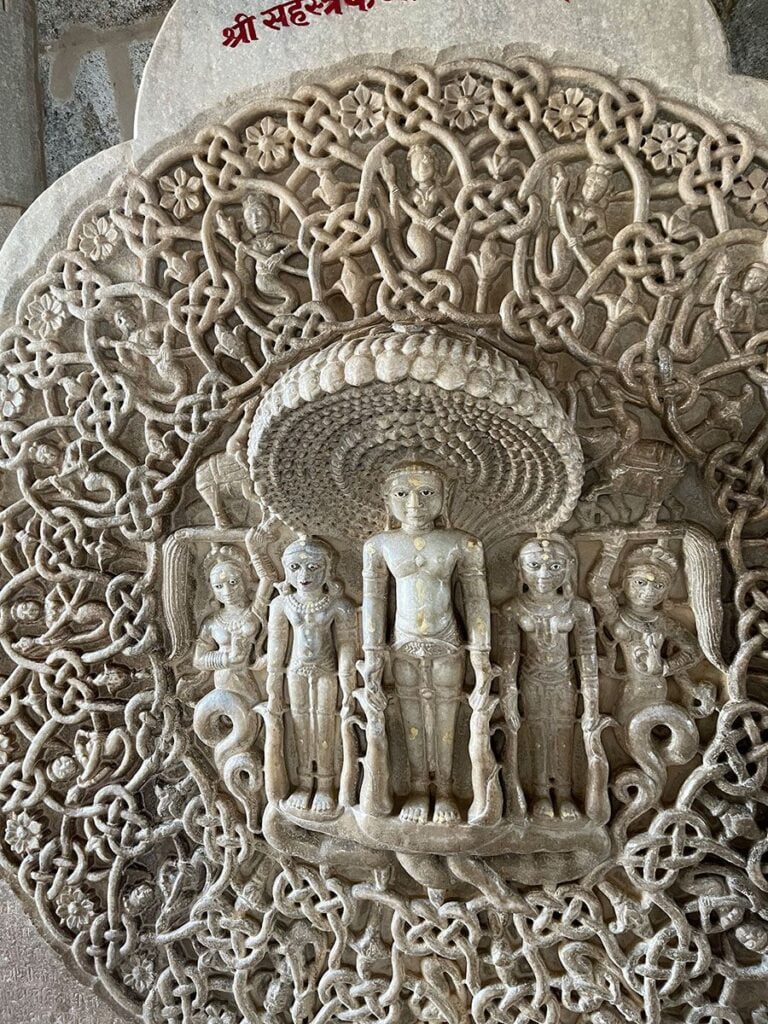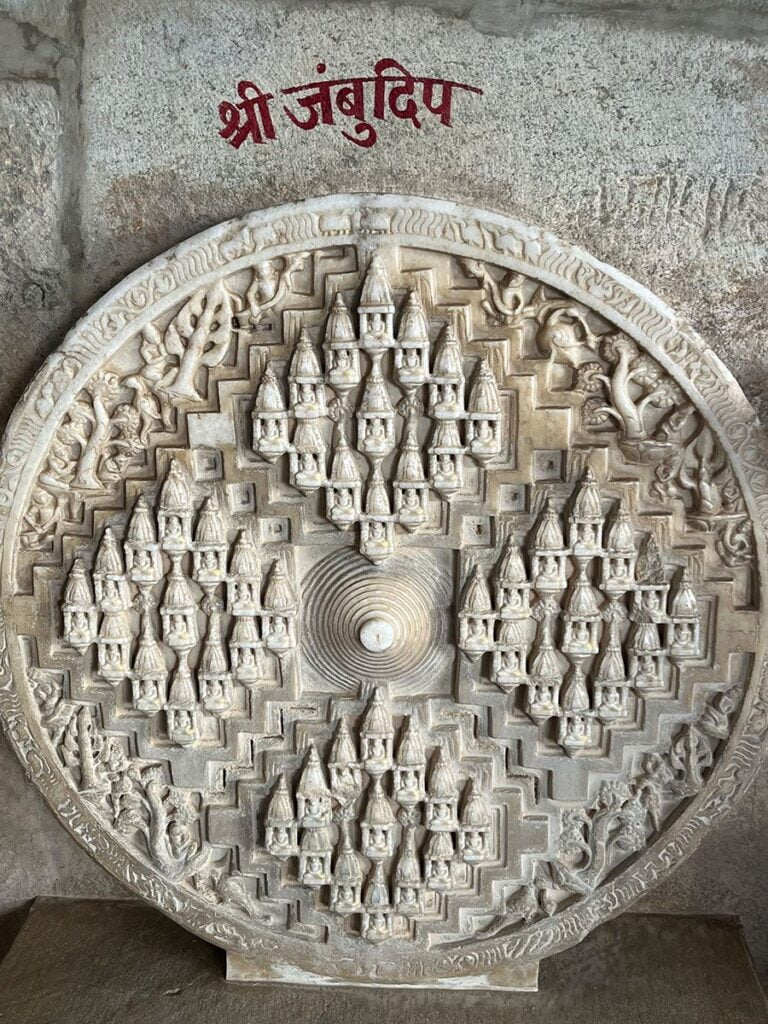Ranakpur Temple | Ranakpur Jain Temple Mystery
The Ranakpur Temple | Ranakpur Jain Temple | Chaturmukha Dharana Vihara, is a Švētāmbara Jain temple located in Ranakpur, Rajasthan, India. It is dedicated to Adinath, the first Tirthankara of the present half-cycle (avasarpiṇī) according to Jain cosmology.

Contents
Ranakpur Temple History:
Origins:
- Built in the 15th century CE (around 1389-1446) by Dharna Shah, a Jain businessman under the patronage of Rana Kumbha, the then ruler of Mewar.
- Legend says Dharna Shah dreamt of a celestial vehicle, inspiring him to build this stunning temple.
- The architect is believed to be Dwepa or Depa, chosen based on his design matching Shah’s dream vision.
Construction:
- Took over 50 years to complete, involving around 2500 workers.
- Built with light-colored marble, featuring intricate carvings and exquisite craftsmanship.
- Not just a temple, but a planned township as advised by Rana Kumbha, with houses and other facilities for residents.
Key features:
- Dedicated to Adinath (Rishabhdev), the first Tirthankara of Jainism.
- Includes four interconnected principal temples: Chaumukh Temple (four-faced temple), Parsvanath Temple, Neminath Temple, and Surya Narayan Temple.
- Boasts over 1444 intricately carved pillars, no two alike, and stunning celestial chariot designs.
- Houses 24 Jain Tirthankara idols and numerous other sculptures depicting deities, mythological figures, and floral motifs.
- Notable for its intricate stonework, open courtyards, and mesmerizing domes and cupolas.
Present day:
- Remains a major pilgrimage site for Jains and a popular tourist destination.
- Recognized for its architectural marvel and cultural significance.
- Continues to be an active temple complex with daily rituals and prayers.
Additional points of interest:
- The temple complex also includes a 13th-century Sun Temple, rebuilt within the grounds.
- Some sections of the temple complex feature erotic art, representing a unique aspect of Jain iconography.
Read More>> Parasnath Temple Giridih 2 BCE Jain Temple

Legend of Ranakpur Temple:
The Dream and the Visionary:
The legend traces the temple’s origin to a devout Jain businessman named Dharna Shah. As the tale goes, Shah had a divine vision in his sleep, witnessing a magnificent celestial chariot with four faces. Inspired by this dream, he yearned to translate it into a tangible expression of his faith.
Seeking Divine Assistance:
Driven by his vision, Shah embarked on a quest to find an architect capable of realizing his dream. He approached numerous skilled artisans, but none could capture the essence of his vision. Finally, he sought the guidance of a revered ascetic named Deepak, known for his wisdom and divine connection.
The Miraculous Design:
Deepak, after deep meditation, presented Shah with a design that perfectly mirrored his dream. The intricate blueprint featured a four-faced central shrine, symbolizing the omnipresence of the first Jain Tirthankara, Adinath. This marked the beginning of the Ranakpur Temple’s remarkable journey.
The King’s Contribution:
Impressed by Shah’s dedication and the divine nature of the design, Rana Kumbha, the then ruler of Mewar, extended his patronage to the project. He not only donated land for the temple’s construction but also agreed to have it named after him, hence the name “Ranakpur.”
Divine Intervention and the Incomplete Pillar:
Legend has it that the temple’s construction wasn’t without its challenges. Despite the best efforts of skilled artisans, a particular pillar repeatedly collapsed overnight. Seeking divine intervention, the workers were advised to keep a lamp burning near the pillar throughout the night. Miraculously, the collapses stopped, and the pillar was finally completed. However, as a reminder of the divine intervention, one pillar remains intentionally incomplete, a testament to the temple’s otherworldly origins.

A Legacy of Faith and Architectural Prowess:
The Ranakpur Temple, standing tall after centuries, continues to be a marvel of intricate carvings, mesmerizing domes, and serene ambiance. The legend adds another layer of mystique to this architectural masterpiece, making it a place where history, faith, and artistry beautifully converge.
Read More>> Tripura Sundari Temple in Tripura
Significance of Ranakpur Temple:
Religious Significance:
- Major Jain Pilgrimage Center: Dedicated to Adinatha, the first Tirthankara (enlightened being) in Jainism, the temple is one of the most important and holiest Jain shrines in India. It’s part of the “Gorwad Panch Tirth”, a group of five sacred Jain pilgrimage sites.
- Spiritual Symbolism: The intricate carvings and architecture represent the Jain ideals of non-violence, asceticism, and spiritual liberation. The temple complex symbolizes the cosmos, with the central Chaumukha temple representing Mount Meru, the center of the universe in Jain cosmology.
Architectural Significance:
- Marvel of White Marble: Built entirely of white marble, the temple complex is a stunning example of 15th-century Indian architecture. It’s famed for its intricate carvings, domes, pillars, and halls, with over 1400 unique pillars and 80 domes.
- Geometric Precision: The entire design showcases incredible geometric precision and symmetry, reflecting the harmony between earthly and spiritual realms in Jain philosophy.
- Largest Jain Temple: The Ranakpur Temple is one of the largest Jain temples in the world, sprawling over 48,000 square feet.
Historical Significance:
- Patronage and Legacy: Built under the patronage of Rana Kumbha, the then ruler of Mewar, the temple reflects the cultural and artistic excellence of that era. It stands as a testament to the collaboration between a merchant and a king for a religious cause.
- Survival and Restoration: Despite facing damage from invasions, the temple has been meticulously restored, showcasing resilience and continuing devotion.
Read More>> Miraculous Powers of Shri Khade Ganesh Temple Kota Kashivpur

Ranakpur Temple Architecture:
The Ranakpur temple’s stunning architecture and intricate carvings have made it a popular tourist destination for centuries.
The temple was built in the 15th century using white marble and is a stunning example of the Maru-Gurjara architectural style. This style is characterized by its intricate carvings, multi-domed roofs, and ornate pillars. The Ranakpur Temple is truly a sight to behold, with its 80 domes, 29 halls, and 1444 pillars, each one uniquely carved.
Here are some of the key architectural features of the Ranakpur Temple:
- Chaumukha Adinath idol: The main idol of the temple is a 6-foot tall, white-colored chaumukha idol of Adinath with four heads facing in four directions. This symbolizes the Tirthankara’s omniscience and his ability to guide devotees in all directions.
- Pillars: The temple is famous for its 1444 intricately carved pillars, each one unique in design. No two pillars are the same, and the intricate carvings depict a variety of motifs, including floral patterns, geometric designs, and figures of gods and goddesses.
- Domes: The temple has 80 domes, supported by nearly 400 columns. The domes are decorated with intricate carvings and add to the grandeur of the temple.
- Halls: The temple has 29 halls, each with its own unique design. The halls are used for various purposes, such as prayer, meditation, and gatherings.
- Shikhara: The temple has a tall shikhara, which is the spire-like tower that crowns the main shrine. The shikhara is decorated with intricate carvings and is a symbol of the temple’s dedication to Lord Adinath.
Read More>> Manibandh Shakti Peeth Pushkar
Ranakpur Jain Temple Mystery:
One of the mysteries of the Ranakpur Jain Temple is how it was built. The temple is made of white marble, which is not found in the Aravalli hills. It is believed that the marble was transported from a quarry in Gujarat, over 200 kilometers away. However, there is no record of how this was done.
Another mystery of the temple is its intricate carvings. The temple is covered in carvings of gods, goddesses, animals, and plants. The carvings are so detailed that it is difficult to imagine how they were created.
Finally, the temple is also known for its complex architecture. The temple is made up of a series of interconnected chambers and courtyards. The layout of the temple is so complex that it is easy to get lost.
The Ranakpur Jain Temple is a fascinating and mysterious place. It is a testament to the skill and ingenuity of its builders.
Here are some of the other mysteries of the Ranakpur Jain Temple:
- The temple is said to have been built in just 50 years, which is an incredibly short time for such a complex structure.
- The temple is perfectly aligned with the sun and the moon, which is a feat of engineering that is still not fully understood.
- The temple is said to be home to a number of hidden chambers and passages, which have never been fully explored.
Read More>> Trinetra Ganesh Temple: Where Ganesha Blesses with 3 Eyes

Ranakpur Temple Timing and Rituals:
Timings:
- For Jains: The temple is open for Jains from 7:00 AM to 12:00 PM. During this time, they can perform their rituals and prayers without any distractions.
- For Non-Jains: The temple is open for non-Jains from 12:00 PM to 5:00 PM. This is to ensure that Jain devotees have their dedicated time for worship.
Rituals:
- Aarti: The main aarti takes place in the evening after sundown, when the temple is illuminated with hundreds of diyas (earthen lamps). This is a beautiful and spiritual experience for everyone present.
- Abhishek: This is a ritual of pouring holy water on the idol of the deity. It is performed by priests and devotees as a form of worship and offering.
- Meditation: The temple is a serene place for meditation and contemplation. There are designated areas where you can sit quietly and focus on your inner self.
- Offerings: Devotees offer flowers, fruits, and other items to the deity as a mark of respect and devotion.
Read More>> Bhimashankar Temple: 6th Jyotirlinga – Lions Seek Blessings
Places to visit near Ranakpur Temple:
- Kumbhalgarh Fort:
- Distance from Ranakpur: Approximately 40 kilometers
- Kumbhalgarh Fort is a Mewar fortress on the westerly range of Aravalli Hills, and it is renowned for its massive wall that stretches over 36 kilometers. The fort provides breathtaking views of the surrounding countryside and houses several palaces, temples, and historical structures.
- Surya Narayan Temple:
- Distance from Ranakpur: Approximately 38 kilometers
- This ancient temple dedicated to the Sun God is known for its exquisite architecture and intricate carvings. The temple is located in Ranakpur itself and is a captivating site for those interested in religious and historical landmarks.
- Muchhal Mahavir Temple:
- Distance from Ranakpur: Approximately 5 kilometers
- Situated near Ghanerao, this temple is dedicated to Lord Mahavir. It is particularly known for its unique feature – a statue of Lord Mahavir with a mustache, making it distinct from other Jain temples.
- Kumbhalgarh Wildlife Sanctuary:
- Distance from Ranakpur: Approximately 50 kilometers
- For nature enthusiasts, the Kumbhalgarh Wildlife Sanctuary offers an opportunity to explore the rich biodiversity of the region. The sanctuary is home to various species of flora and fauna, including leopards, sloth bears, and a variety of bird species.
- Ranakpur Dam:
- Distance from Ranakpur: Approximately 10 kilometers
- The Ranakpur Dam, also known as Ranakpur Jalashay, is a serene and picturesque spot. Visitors can enjoy a peaceful environment, surrounded by hills and greenery. It’s a great place for a leisurely stroll or a picnic.
- Parshuram Mahadev Temple:
- Distance from Ranakpur: Approximately 80 kilometers
- Located in the Kumbhalgarh Sanctuary, this temple is dedicated to Lord Parshuram, an incarnation of Lord Vishnu. It is situated in a cave and requires a trek to reach, providing a unique and spiritual experience.
- Sadri:
- Distance from Ranakpur: Approximately 8 kilometers
- Sadri is a small town near Ranakpur known for its various temples, including the Varahavtar Temple and the Chintamani Parsvanath Temple. These temples showcase impressive architecture and intricate carvings.
- Narlai:
- Distance from Ranakpur: Approximately 20 kilometers
- Narlai is a charming village surrounded by hills. It is known for the elephant-shaped rock, numerous step wells, and the Adinath Temple. The rustic beauty and cultural heritage of Narlai make it a delightful stop for travelers.
Read More>> Tirumala Tirupati Venkateswara Swamy
FAQ:
- Where is Ranakpur Temple located?
- Ranakpur Temple is located in the village of Ranakpur in the Pali district of Rajasthan, India. It is approximately 91 km north of Udaipur.
- What is the significance of Ranakpur Temple?
- Ranakpur Temple is renowned for its stunning architecture and intricate marble carvings. Dedicated to Adinatha, a Tirthankara in Jainism, the temple is considered one of the most important and largest Jain temples in India.
- How do I reach Ranakpur Temple?
- The nearest airport is Maharana Pratap Airport in Udaipur, and the nearest railway station is Falna. From these points, you can hire a taxi or use local transportation to reach Ranakpur.
- What are the temple timings?
- The temple is generally open from 7:00 AM to 7:00 PM. However, it’s advisable to check the timings before planning your visit, as they may be subject to change.
- Is there an entry fee for Ranakpur Temple?
- Yes, there is usually a nominal entry fee for visitors. The fee may vary for Indian and foreign tourists. It’s recommended to check the current entry fees before your visit.
- Can non-Jains visit the temple?
- Yes, Ranakpur Temple is open to people of all religions and backgrounds. However, visitors are expected to adhere to the temple’s rules and regulations, which may include dress codes and photography restrictions.
- Are there any dress code requirements for visiting the temple?
- Yes, modest attire is encouraged. Both men and women are advised to cover their shoulders and knees as a sign of respect when entering the temple.
- Are photography and videography allowed inside the temple?
- Photography is generally allowed in the outer areas of the temple, but it is often restricted inside the main sanctum and certain other sacred areas. It’s essential to respect these guidelines to maintain the sanctity of the temple.
- Is there a specific time to visit Ranakpur Temple?
- While the temple is open throughout the day, many visitors prefer to visit in the morning or late afternoon when the sunlight enhances the beauty of the marble carvings. However, any time during the temple’s operational hours is suitable for a visit.
- Are there any nearby attractions to explore in Ranakpur?
- Yes, apart from the temple, Ranakpur offers scenic surroundings and other attractions like the Kumbhalgarh Fort, Muchhal Mahavir Temple, and the Sadri Village, making it a destination with historical and cultural significance.
- How much time is required to visit Ranakpur Jain Temple?
- Quick Visit (1-2 hours):
- If you are on a tight schedule or prefer a quick overview, you can explore the main areas of the temple, admire the architectural marvels, and offer your prayers. This would typically take around 1 to 2 hours.
- Detailed Exploration (2-3 hours):
- For a more in-depth experience, allowing time for contemplation and appreciation of the detailed marble carvings, you might want to spend 2 to 3 hours. This allows you to explore the various chambers, halls, and intricacies of the temple architecture.
- Photography Enthusiasts (2-3 hours):
- If you enjoy photography and want to capture the beauty of the temple, you may need additional time. Photographers often spend extra time framing shots and exploring different angles. Allocate 2 to 3 hours or more if photography is a priority.
- Combined Visit with Nearby Attractions (Full Day):
- If you plan to visit other attractions in the Ranakpur area, such as Kumbhalgarh Fort or Muchhal Mahavir Temple, you may need a full day. Each additional site will require its own exploration time.
- Quick Visit (1-2 hours):
How to reach Ranakpur Temple:
By Air: The nearest airport to Ranakpur is Maharana Pratap Airport (UDR) in Udaipur, which is approximately 94 kilometers away. From the airport, you can hire a taxi or use other local transportation options to reach Ranakpur.
By Train: The nearest railway station to Ranakpur is the Falna Railway Station, which is about 30 kilometers away. You can take a train to Falna and then hire a taxi or use local transportation to reach Ranakpur.
By Road: Ranakpur is well-connected by road, and you can reach the temple by taking a bus or hiring a taxi. The village is accessible from major cities in Rajasthan, such as Udaipur and Jodhpur. You can also drive to Ranakpur if you prefer a more private mode of transportation.
From Udaipur: If you are traveling from Udaipur, you can take the NH32 road towards Kumbhalgarh. Ranakpur is situated on this route. The distance between Udaipur and Ranakpur is approximately 91 kilometers, and the journey takes around 2 to 3 hours by road.
From Jodhpur: If you are coming from Jodhpur, you can take the NH62 road towards Pali and then continue on the NH32 towards Falna. Ranakpur is located on this route. The distance between Jodhpur and Ranakpur is approximately 162 kilometers, and the journey takes around 3 to 4 hours by road.
